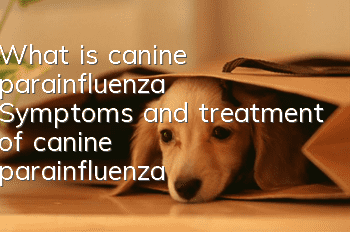What is canine parainfluenza? Symptoms and treatment of canine parainfluenza

Canine parainfluenza is an infectious disease mainly characterized by respiratory symptoms caused by canine parainfluenza virus (CPIV). Clinically it is characterized by fever, runny nose and cough, catarrhal rhinitis and bronchitis. It is one of the causative agents of kennel cough in young dogs and mainly infects puppies.
【Pathogens and Epidemiology】
1. Pathogen: Canine parainfluenza virus belongs to the family Paramyxoviridae, genus Paramyxovirus, and is a single-stranded RNA virus. The natural route of infection is mainly the respiratory tract.
2. Source of infection: Dogs in the acute phase are the main source of infection.
3. Susceptible animals: Dogs of various breeds, ages, and genders can be infected, but puppies are more severely infected and have a longer course of disease.
4. Epidemic characteristics: It can occur in different seasons. Poor sanitary conditions, crowding, long-distance transportation, and stress can aggravate the disease. Most cases are sudden outbreaks and widespread epidemics. This disease is endemic in almost all countries in the world.
【Symptoms】
Main manifestations: respiratory tract catarrhal inflammation, cough, initially large amounts of serous, then mucous, opaque nasal secretions.
Clinical features: The disease onset is acute and the infection is rapid. The disease often occurs first in a certain litter of dogs in the dog farm and then spreads rapidly throughout the dog farm, showing an outbreak. Sick dogs have dry cough, serous or mucus rhinorrhea, fatigue, and lack of energy. The course of the disease can last more than 3 weeks. If mixed infection with mycoplasma or Bordetella bronchiseptica (i.e. kennel cough), the condition will worsen.
Some dogs show symptoms such as hindquarter paralysis and ataxia after infection. If the disease is not complicated by or secondary infection, the prognosis is generally good and the mortality rate is low. However, sick dogs are young and may die if not properly treated.
【Necropsy lesions】
Serous or mucopurulent nasal secretions around the nostrils, conjunctivitis, inflammatory changes in the tonsils, trachea, bronchi and lungs, and sometimes punctate bleeding in the lungs can be seen in dead dogs. Neurological dead dogs may have acute encephalomyelitis and hydrocephalus.
【Diagnosis】
A preliminary diagnosis can be made based on the clinical symptoms, epidemiology, and autopsy changes of the disease. Similar to the clinical symptoms of canine respiratory infectious diseases, laboratory examination methods should be used for differential diagnosis, and cell culture can be used to isolate and identify the pathogen. Serum neutralization test and hemagglutination inhibition test are used to check whether the antibody titer of double sera increases, which can be used for epidemiological investigation and retrospective diagnosis of this disease.
【Treatment】
Main treatmentIt is symptomatic treatment and prevention of secondary infection.
Compound licorice mixture, Federal Cough Lotion, etc. can be used for dogs with dry cough. Ultrasonic aerosol therapy can be used for dogs with severe cough. Dogs with poor appetite can be given intravenous infusion of isotonic glucose solution, and attention should be paid to supplementing ATP, coenzyme A, vitamin C, and B family. Vitamins; This disease is often secondary to infection with Bordetella bronchiseptica and Mycoplasma. To prevent secondary infection, cephalosporin, lincomycin, ampicillin, etc. can be used; for antiviral infections, ribavirin, etc. can be used to improve resistance. , hyperimmune serum or intravenous serum albumin can be given.
【Prevention】
The main prevention of this disease is immunization. At present, the six-linked attenuated vaccine and the five-linked attenuated vaccine for dogs containing canine parainfluenza attenuated vaccine are commonly used in China. Generally, puppies are first vaccinated when they are 6 to 8 weeks old, and then 2 weeks later. Better results can be achieved by inoculating 3 times consecutively at intervals. Since the disease is mainly spread through the air and respiratory tract, once it occurs, it will quickly spread to the entire dog population and is difficult to control.
Recommended Good Things
Aineng Pet Odor Eliminating Disinfectant can effectively remove body odor/feces odor and other odor molecules! Effective in treating skin diseases caused by fungi/bacteria! Can kill parvovirus/canine distemper virus/coronavirusetc!
It is edible grade for pets, does not contain fragrances, does not contain chemicals, can be sprayed directly, and is harmless to human pets!
Consultation: 13028809308 (WeChat synchronization)
Scan the QR code on WeChat to enter the purchase
- Can dogs get tooth decay?
- How much does a Shih Tzu cost and is it easy to keep?
- Can dogs eat watermelon in summer?
- Is Pug a picky eater if he doesn’t eat dog food well? Pug dogs are picky and don’t eat dog food!
- There are several foods that are not good for your dog’s health, not even one bite!
- Do Pomeranians have body odor?
- What kind of food should dogs eat?
- Teach you four steps to identify good dog food!
- What should you pay attention to when choosing a dog house?
- Oral diseases in dogs and cats are very harmful, teach you how to identify and prevent them!



